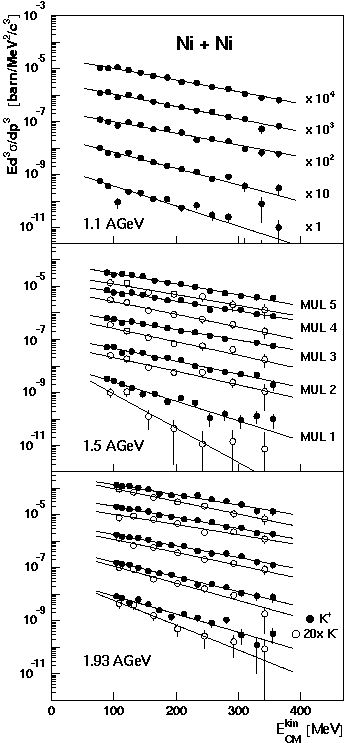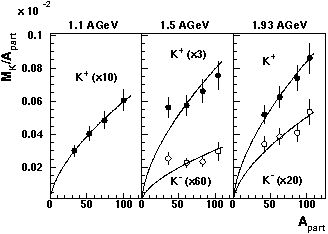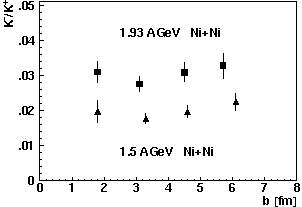
|
|---|
|
Fig. 1 K+ and K- invariant cross sections as a function of the kinetic energy and the centrality of the reaction measured around midrapidity (qlab = 40°±4°) for Ni+Ni collisions at different beam energies (preliminary). |
|
Centrality Dependence of Kaon and Antikaon Production in Ni+Ni
Collisions at SIS Energies B,G |
|---|
| M. Menzel4, I.M. Böttcher4, M. Debowski5,6, F. Dohrmann6, A. Förster2, E. Grosse6,7, P. Koczon1, B. Kohlmeyer4, F. Laue1,*, L. Naumann6, H. Oeschler2, F. Pühlhofer4, W. Scheinast6, E. Schwab1, P. Senger1, Y. Shin3, H. Ströbele3, C. Sturm2, G. Surówka5, F. Uhlig2, A. Wagner6, W. Walus5 |
|
Kaons and antikaons are regarded as a promising probe to study hadron properties in dense nuclear matter. Recent experimental results obtained with the Kaon Spectrometer indicate modifications of the in-medium properties of K+ and K-. Remarkable results are that the K-/K+ ratio is enhanced compared to pp collisions [1,2,3], the spectral slope for the antikaons is steeper than for the kaons [2] and a preferential out-of-plane emission of K+ is observed [4].
In order to study the kaon production as a function of the reaction centrality
and the beam energy, we have measured K+ and K- mesons around
midrapidity (qlab = 40°±4° ) in Ni+Ni reactions at beam
energies of
1.1 (K+ only), 1.5 and 1.93 AGeV. The multiplicity of charged particles
measured by a target hodoscope is used to determine the centrality. The
data set is subdivided in five centrality bins MUL1 to MUL5 for each beam
energy. From a measurement under minimum bias conditions the reaction cross
section is determined. For all beam energies we find a reaction cross section
of sR = 2.9±0.3 barn, which agrees with the
geometric model. The relative reaction cross section for each centrality
class sR,MUL/sR is given in Table 1 for 1.5 and 1.93 AGeV.
Errors of about 10 % have to be added to the ratio sR,MUL/sR.
|

|
|---|
|
Fig. 1 K+ and K- invariant cross sections as a function of the kinetic energy and the centrality of the reaction measured around midrapidity (qlab = 40°±4°) for Ni+Ni collisions at different beam energies (preliminary). |
Table 1 Relative reaction cross sections, K+ and K- production cross sections and inverse slope parameters as a function of the centrality for Ni+Ni collisions at beam energies of 1.5 and 1.93 AGeV (preliminary). |

|
|

|
|
Fig. 2 Kaon and antikaon multiplicity per APart as a function of APart for Ni+Ni collisions at beam energies of 1. 1, 1.5 and 1.93 AGeV (preliminary). |
|
Fig. 3 K-/K+ ratio as a function of the impact parameter b for Ni+Ni collisions at beam energies of 1.5 and 1.93 AGeV (preliminary). |
References [1] R. Barth et al., Phys. Rev. Lett. 78 (1997) 4007 [2] F. Laue et al., Phys. Rev. Lett. 82 (1999) 1640 [3] M. Menzel et al., Phys. Lett. B 495 (2000) 26 [4] Y. Shin et al., Phys. Rev. Lett. 81 (1998) 1576
|